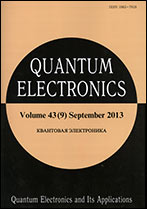| Kvantovaya Elektronika |
|
|


|
|
|
This article is cited in 7 scientific papers (total in 7 papers) Particle acceleration Electron acceleration in the regime of relativistic self-trapping of extreme light V. Yu. Bychenkovabc, M. G. Lobokabc a P. N. Lebedev Physical Institute of the Russian Academy of Sciences, Moscow b All-Russia Research Institute of Automatics named after N L Dukhov, Moscow c Federal Research Center The Institute of Applied Physics of the Russian Academy of Sciences, Nizhny Novgorod Citation: V. Yu. Bychenkov, M. G. Lobok, “Electron acceleration in the regime of relativistic self-trapping of extreme light”, Kvantovaya Elektronika, 53:2 (2023),
This publication is cited in the following 7 articles:
|


|
||||||||||||||||||||||||||||||||||||||||||||||||||||||||||||||||||

|
 Contact us:
Contact us:math-net2025_04@mi-ras.ru |
 Terms of Use Terms of Use
|
 Registration to the website Registration to the website |
 Logotypes Logotypes |
|










